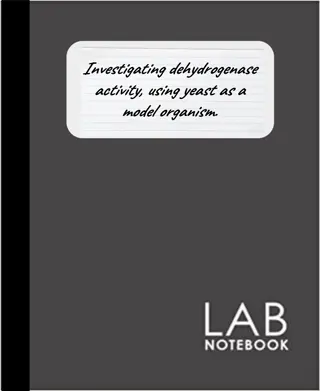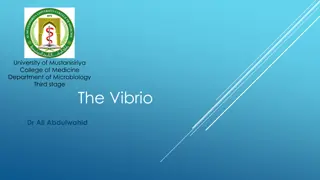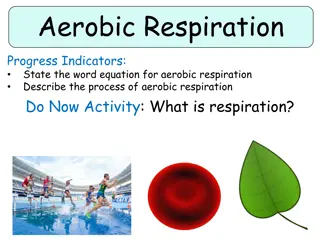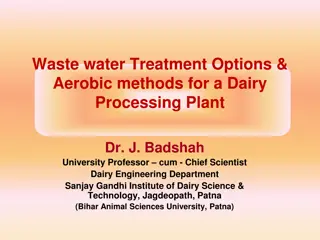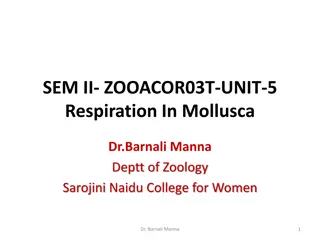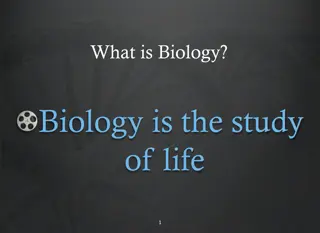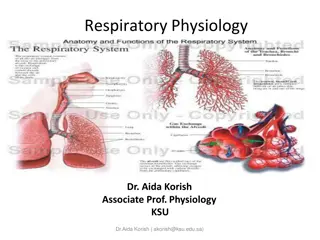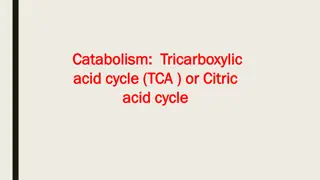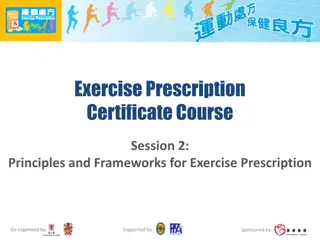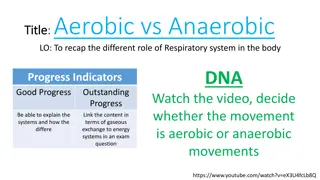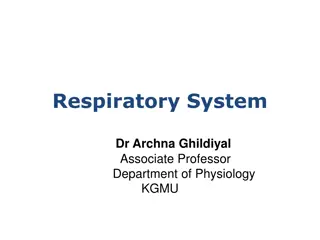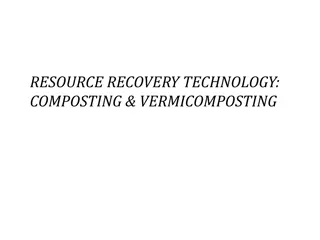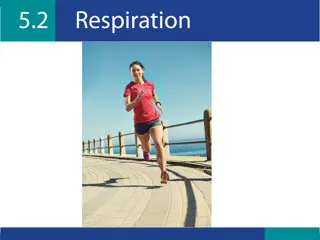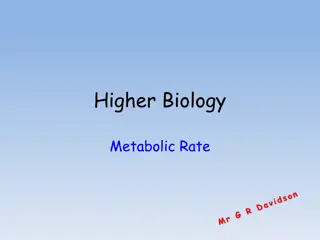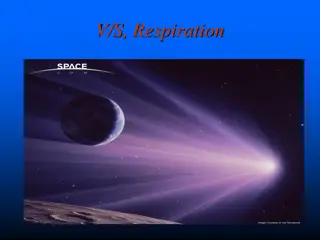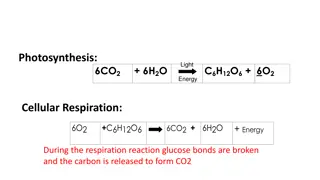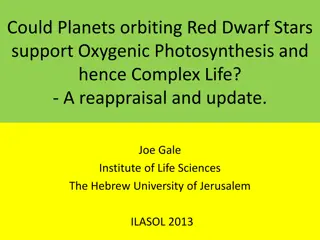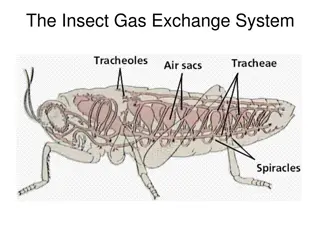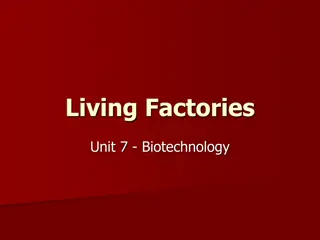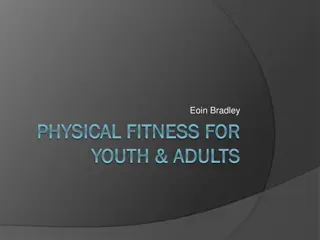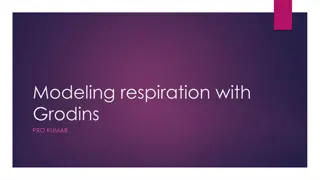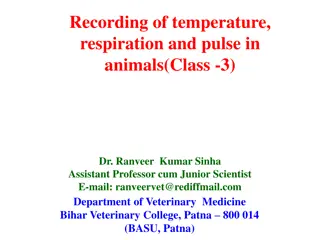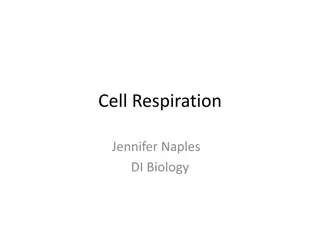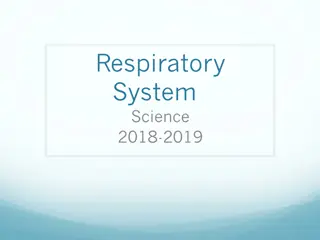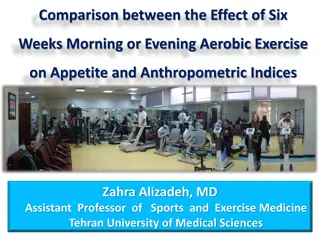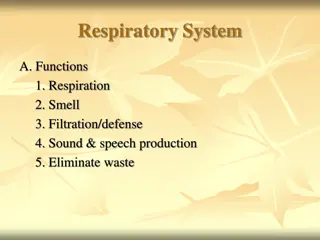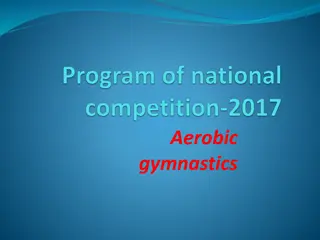Respiration
The definition and role of aerobic respiration, the overall sequence of reactions for glucose, and the two-stage process. Explore the concepts of anaerobic respiration and fermentation, including the role of microorganisms in industrial fermentation. Discover the cellular location of each stage and
0 views • 11 slides
Insect Abdominal Structures and Appendages: An Overview
The abdomen of insects plays crucial roles in respiration, reproduction, digestion, excretion, and metabolism. The number of abdominal segments varies across species, with reductions and modifications seen in different insect groups. From the propodeum to pregential and postgenital segments, each pa
1 views • 6 slides
Investigating Dehydrogenase Activity Using Yeast
This investigation focuses on exploring respiration in yeast by tracking the breakdown of glucose using dehydrogenase enzymes. The experiment involves immobilizing yeast into gel balls and measuring the change in color of resazurin dye to quantify the rate of respiration. Safety measures, risk asses
2 views • 11 slides
Overview of Glucose Metabolic Pathways in Clinical Chemistry
Explore the major metabolic pathways of glucose, including glycogenolysis, gluconeogenesis, glycolysis, and more. Understand the production, utilization, catabolic, and anabolic cycles of glucose in cellular metabolism. Learn about key concepts such as hexose interconversion, HMP/PPP, Krebs cycle, a
4 views • 29 slides
Understanding Cellular Respiration and Metabolism in Living Organisms
Cellular respiration is a vital process in all living cells, producing energy through chemical reactions. Metabolism, consisting of anabolism and catabolism, maintains growth and function. ATP plays a central role as energy currency in cells. Through stages like glycolysis and the Krebs cycle, cellu
0 views • 16 slides
Understanding Vibrio Cholerae: Biology and Impact on Human Health
Vibrio cholerae is a significant bacterium responsible for causing cholera, a life-threatening diarrheal disease. With over 35 species in the Vibrio genus, only a few can infect humans. Vibrio cholerae is a Gram-negative, curved aerobic rod that produces an enterotoxin leading to cholera. Understand
0 views • 23 slides
Understanding Aerobic Respiration and Cell Structures
Explore the process of aerobic respiration, why we need oxygen for energy production, and the importance of cell structures in this metabolic pathway. Discover the role of key organelles like mitochondria and the cell membrane, as well as the differences between animal and plant cells in respiration
0 views • 10 slides
Understanding Cellular Respiration and Oxygen Delivery
Cellular respiration, a vital process for organ survival, involves mitochondria performing cellular respiration by utilizing glucose and oxygen. Glucose is derived from diet or body breakdown, while oxygen enters through the respiratory system, facilitated by red blood cells in the circulatory syste
0 views • 8 slides
Waste Water Treatment Options for Dairy Processing Plants
Factors influencing waste water treatment options for a dairy processing plant include volume and flow rates, chemical characteristics, biodegradability, controlling levels of suspended solids, BOD, and COD in discharged water. Dairy wastes have high BOD due to lactose, fats, proteins, nitrogen, and
0 views • 17 slides
Respiration in Mollusca: Adaptations to Different Habitats
Mollusca exhibit various modes of respiration depending on their habitat - aquatic, terrestrial, or amphibious. Different respiratory organs are modified accordingly, such as ctenidia or gills for aquatic species, pulmonary sac for aerial species, and mantle or integument for those lacking specific
0 views • 17 slides
The Basics of Life: Understanding Biology and Life Functions
Biology is the study of life, which involves understanding the characteristics that define living organisms. These characteristics include nutrition, transport, respiration, excretion, synthesis, regulation, and growth. Each of these life functions is essential for the survival and functioning of al
0 views • 14 slides
Understanding the Respiratory System and Its Functions
Within the complex respiratory system, the goal is to provide oxygen to tissues and remove CO2. It consists of airways, muscles, and centers. Functions include gas exchange, phonation, and pulmonary defense. The system also performs non-respiratory functions like converting Angiotensin I to II, regu
3 views • 29 slides
Overview of Cellular Respiration Pathways and ATP Generation
Cellular respiration involves key processes like the Tricarboxylic Acid Cycle (TCA), Electron Transport Chain, and ATP generation pathways. The TCA cycle utilizes Acetyl-CoA to produce energy-rich molecules, while the Electron Transport Chain facilitates ATP synthesis through oxidative phosphorylati
0 views • 18 slides
Explore Cellular Respiration Through POGIL Activities
Dive into the world of cellular respiration through POGIL activities that cover topics such as glycolysis, Krebs Cycle, Electron Transport System, and more. Discover critical thinking questions and application problems related to cellular respiration processes and their real-world implications.
0 views • 6 slides
Principles and Frameworks for Exercise Prescription Certificate Course Session 2
This session delves into the principles and frameworks for exercise prescription, focusing on topics such as prescribing aerobic exercise, the FITT principle, global recommendations for physical activity, and practical aerobic exercise examples. It also covers the benefits of regular physical activi
0 views • 48 slides
Understanding Aerobic and Anaerobic Exercise Systems
The content discusses the differences between aerobic and anaerobic exercise, detailing how each system utilizes oxygen or stored energy for energy production. It explores the role of gaseous exchange in energy systems and relates it to the respiratory system's function. Additionally, it covers the
0 views • 9 slides
Understanding Anaerobic Respiration in Cell Biology - Year 10 Science Lesson
Exploring the concepts of anaerobic respiration in cell biology with Ms. Merrall. Learn about the differences between aerobic and anaerobic respiration, muscle fatigue, and oxygen debt. Discover the importance of respiration for survival, building upon previous knowledge and linking to various topic
0 views • 20 slides
Understanding Neural Control of Respiration in the Respiratory System
The lecture discusses the regulation of respiration, focusing on the neural control of breathing rhythm, ramp signals, lung receptors, and the role of different groups of neurons in the respiratory center. Key topics include inspiratory ramp signals, controlling the rate of respiration, and the func
0 views • 35 slides
Understanding Composting and Vermicomposting Technology
Composting and vermicomposting are controlled decomposition processes of organic materials, with aerobic microbes breaking down the matter in the presence of oxygen. Aerobic composting produces stable humus and helps eliminate pathogens and weed seeds. The processes involve microbial respiration, ga
1 views • 29 slides
Understanding Cellular Respiration Through Investigation
Explore the key concepts related to cellular respiration, including the substances needed, products produced, sources of substances, the respiration equation, effects of exercise, and comparison with photosynthesis. Engage in practical activities like investigating the factors affecting respiration
1 views • 24 slides
Understanding Neural Control of Respiration in the Respiratory System
Explore the intricate mechanisms of neural control of respiration within the respiratory system, focusing on key components such as the respiratory center in the medulla and the role of inspiratory ramp signals in regulating breathing rhythms. Gain insights into the automatic and voluntary aspects o
1 views • 35 slides
Understanding Metabolic Rate in Biology: Measurement and Importance
Metabolic rate, the energy consumed by an organism in a specific time period, can be measured through heat energy, oxygen consumption, and carbon dioxide release. Various tools like calorimeters and respirometers are used for this purpose. The delivery of oxygen through efficient transport systems i
0 views • 28 slides
The Fascinating World of Food Fermentation
Explore the rich history and benefits of fermentation, from the early nomads' discovery of cheese and yogurt to Louis Pasteur's groundbreaking work. Learn about the different types of respiration, microbial fermentation in food production, and the energy-releasing process of cell respiration. Discov
0 views • 13 slides
Understanding Respiration and Breathing Process
Respiration is the vital process of inhaling and exhaling air to facilitate the exchange of oxygen and carbon dioxide in the body. It involves external and internal respiration, with mechanisms such as costal and diaphragmatic breathing. The regulation of breathing is controlled by the respiratory c
0 views • 21 slides
Understanding Cellular Respiration in Plants and Animals
Explore the intricate processes of photosynthesis and cellular respiration, uncovering how plants and animals utilize glucose, oxygen, and energy to sustain life. Discover the essential role of ATP production and the interdependent relationship between carbon dioxide and oxygen in the environment.
0 views • 12 slides
The Potential for Oxygenic Photosynthesis on Planets Orbiting Red Dwarf Stars
Exploring the possibility of oxygenic photosynthesis and complex life on planets orbiting red dwarf stars, considering factors such as star life cycles, climate conditions, and radiation wavelengths. The evolution of complex life on Earth due to the essential role of oxygen and ozone is discussed in
0 views • 14 slides
Understanding the Insect Gas Exchange System
The insect gas exchange system involves spiracles, tracheae, and tracheoles that facilitate the exchange of gases to support respiration in insects. Spiracles lined with chitin control airflow, while tracheae and tracheoles enable oxygen to dissolve into the haemolymph through passive diffusion, sup
0 views • 18 slides
Understanding Yeast: The Living Organism and Its Respiration Processes
Explore the world of Saccharomyces cerevisiae (yeast) as a single-celled fungus that exists on all living matter. Learn about its genetic similarities to humans, its basic survival needs, and the processes of aerobic and anaerobic respiration, including fermentation. Discover how yeast, like us, rel
0 views • 26 slides
Comprehensive Physical Fitness and Training Guide by Eoin Bradley
Explore the realm of physical fitness through Aerobic Endurance, Skills, Strength, Speed, Power, Flexibility, Mobility, and Agility. Unveil the importance of Mobility, Flexibility, Strength, Aerobic Endurance, and more. Delve into specific training requirements for GAA Football and seasonal training
0 views • 23 slides
Understanding the Respiratory System and Its Functions
The respiratory system is vital for gas exchange in the body, involving processes like pulmonary ventilation, external and internal respiration. It includes organs like the nose, pharynx, larynx, and trachea, which help in conducting air to the alveoli. This system facilitates the exchange of oxygen
1 views • 14 slides
Understanding Grodins Pro Kumar's Model of Respiration
Explore the historical background and compartments of Grodins Pro Kumar's modeling of respiration, from differing breathing rates to the layout and assumptions of lungs, brain, and soft tissue. Learn how the homogeneous system is applied and the methods used to analyze this complex respiratory model
0 views • 18 slides
Cyanide's Impact on Respiration Through Enzyme Inhibition
Cyanide, a noncompetitive inhibitor of the enzyme cytochrome c oxidase, disrupts electron transport in respiration by binding to the iron cofactor and blocking electron transfer to oxygen. This lethal effect was utilized in gas chambers during WWII, underscoring the crucial role of enzyme function i
0 views • 7 slides
Animal Temperature, Respiration, and Pulse Recording Guide
Learn how to record the temperature, respiration, and pulse in animals for diagnosing febrile diseases and monitoring health. Understand the techniques, precautions, factors affecting temperature, and causes of hypothermia in animals. Follow Dr. Ranveer Kumar Sinha's comprehensive instructions to en
0 views • 20 slides
Understanding Cellular Respiration: Energy Production in Organisms
Organisms can be classified into autotrophs that use sunlight for photosynthesis and heterotrophs that rely on consuming food. Regardless of food source, all organisms obtain energy through cellular respiration, a process that converts stored chemical energy into ATP. This energy currency is essenti
0 views • 21 slides
Understanding Cell Respiration and the Importance of Food in Biology
Cell respiration is a vital process that releases energy by breaking down glucose in the presence of oxygen. Food provides essential building blocks and energy for growth and reproduction. The chemical energy in food is significant, as one gram of sugar can release a substantial amount of heat energ
0 views • 17 slides
Understanding Cellular Respiration and Fermentation Processes
Cellular respiration is the energy-releasing process in which organisms take in glucose and oxygen to produce carbon dioxide, water, and energy. This process is vital for all living organisms. Photosynthesis and respiration are opposite processes, with respiration requiring the products of photosynt
0 views • 10 slides
Understanding the Respiratory System and the Process of Respiration
The respiratory system is vital for breathing as it helps in the exchange of oxygen and carbon dioxide. This system consists of organs such as the lungs, bronchi, and alveoli. The process of respiration involves inhaling air through the nose or mouth, passing it through the trachea and bronchi into
0 views • 5 slides
Effect of Six Weeks Morning or Evening Aerobic Exercise on Appetite and Anthropometric Indices
This study by Dr. Zahra Alizadeh explores the impact of six weeks of morning or evening aerobic exercise on appetite and anthropometric indices in overweight females. The research aims to understand how exercise timing affects these factors in sedentary overweight women aged 20-45, excluding those w
0 views • 37 slides
Overview of the Respiratory System Functions and Anatomy
The respiratory system has vital functions such as respiration, smell, filtration/defense, sound & speech production, and waste elimination. It consists of external (root, bridge, apex, and nostrils) and internal components (nasal cavity, pharynx, larynx). The nose/nasal cavity provides an airway fo
0 views • 37 slides
Aerobic Gymnastics Competition Guidelines and Rules
The guidelines for aerobic gymnastics competitions include compulsory elements, categories, competition spaces, deductions, and specific rules for different age groups. The competitions have specific parameters for elements allowed, lifting, floor elements, music length, maximum difficulty elements,
0 views • 17 slides


